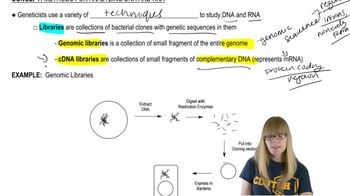Table of contents
- 1. Introduction to Genetics51m
- 2. Mendel's Laws of Inheritance3h 37m
- 3. Extensions to Mendelian Inheritance2h 41m
- 4. Genetic Mapping and Linkage2h 28m
- 5. Genetics of Bacteria and Viruses1h 21m
- 6. Chromosomal Variation1h 48m
- 7. DNA and Chromosome Structure56m
- 8. DNA Replication1h 10m
- 9. Mitosis and Meiosis1h 34m
- 10. Transcription1h 0m
- 11. Translation58m
- 12. Gene Regulation in Prokaryotes1h 19m
- 13. Gene Regulation in Eukaryotes44m
- 14. Genetic Control of Development44m
- 15. Genomes and Genomics1h 50m
- 16. Transposable Elements47m
- 17. Mutation, Repair, and Recombination1h 6m
- 18. Molecular Genetic Tools19m
- 19. Cancer Genetics29m
- 20. Quantitative Genetics1h 26m
- 21. Population Genetics50m
- 22. Evolutionary Genetics29m
18. Molecular Genetic Tools
Methods for Analyzing DNA
Problem 12a
Textbook Question
Textbook QuestionThree independently assorting STR markers (A, B, and C) are used to assess the paternity of a colt recently born to a quarter horse mare. Blood samples are drawn from the mare, her colt, and three possible male sires (S₁, S₂, and S₃). DNA at each marker locus is amplified by PCR, and a DNA electrophoresis gel is run for each marker. Amplified DNA bands are visualized in each gel by ethidium bromide staining. Gel results are shown below for each marker. Calculate the PI and CPI based on these STR markers, using the following population frequencies: A₁₂ = 0.12, A₁₀ = 0.18; B₁₈ = 0.08, B₁₂ = 0.17; C₁₆ = 0.11, C₁₄ = 0.20.
 Verified Solution
Verified SolutionThis video solution was recommended by our tutors as helpful for the problem above
Video duration:
4mPlay a video:
207
views
Was this helpful?
Related Videos
Related Practice

